Op-Ed: Maritime Perspective Sheds Light on US-Iran Nuclear Negotiations

Rising tensions between Iran and the United States are casting a shadow over the Middle East region. GCC nations in particular are concerned that commerce will be disrupted should a breakdown in the Omani-mediated talks between the United States and Iran have a military fallout.
Reports suggest that the critical closing stages of negotiations have reached a stalemate, with the normally reticent Omani Foreign Minister Sayyid Badr Al Busaidi acknowledging that while progress has been made obstacles remain. The sticking point in the negotiations appears to revolve around uranium enrichment, which Iran wishes to continue at the 3.67 percent level needed for civil purposes, but which the United States wishes to see ended completely. Amongst solutions to the impasse being discussed is the idea that Iran could carry out processing in a third country, under International Atomic Energy Agency (IAEA) oversight. During its many years of conducting nuclear inspections in Iran, the IAEA has by in large maintained its reputation for probity and impartiality.
However, with the negotiations at a critical juncture, the IAEA has published a report requested by its Board of Governors which describes work that Iran has attempted to hide from IAEA inspections. Iran’s covert nuclear weapons development agency SPND has apparently conducted work at three undeclared sites (Lavisan-Shian, Varamin, and Turquzabad) to perfect nuclear weapon trigger devices, and has also built up a 408kgs stock of 60 percent enriched uranium, sufficient with limited additional processing to build nine nuclear weapons and a stockpile not needed for any civil purpose. If its Board of Governors endorses the report, then the IAEA could refer Iran to the UN Security Council as being in breach of its non-proliferation obligations. This in turn could oblige Britain, France, and Germany to re-impose snap-back sanctions even before U.S.-Iranian negotiations have reached a dead-end.
With the IAEA report coming at a critical point in the negotiations, but with Iran arguably already breaching Israel’s declared red-line prohibition on nuclear weapons development, President Donald Trump has urged Israel not to attack. Trump believes success in the negotiations is still possible, and that this would remove the risks of resorting to warfare. On his recent trip to the Gulf, Trump was urged by all Arab leaders to discourage attacks on Iran, for fear of disturbing the status quo and the collateral consequences for the region.
How Iran should now proceed has evidently divided the Iranian political leadership. Hardliners around the Supreme Leader, amongst whom are the commanders of the Islamic Revolutionary Guard Corps (IRGC), have urged that no concessions be made in the negotiations, arguing that Iran’s defenses are strong enough to resist an Israeli attack, and with some now maintaining that it is acceptable within Islamic teaching for Iran to proceed with the development of low yield nuclear weapons. For hardliners, an Israeli attack would be survivable and justification for completing the deployment of nuclear weapons.
Opposition to the hard-liners’ stance is led by the reformist President Masoud Pezeshkian. It is probable that President Pezeshkian’s desire for a successful end to the negotiations, which would see an easing of sanctions and hence an easing of the current economic crisis, was reinforced in his visit last week to Sultan Haitham of Oman, who is determined to see the negotiations end fruitfully and tensions reduced in the region.
While at this delicate stage of the negotiations, the hardliners are being bombastic, the reformists are anxious to avoid providing any provocation or excuse for the talks to be abandoned. This posture is very evident in the current deployments of Iran’s regular armed forces, who tend to align with the moderate reformist faction, whilst the IRGC makes up the hardliner core.
This alignment is apparent in the current deployments of Iran’s regular Navy (Nedaja). Besides having withdrawn its flotilla which hitherto had maintained a constant presence in the Red Sea and Gulf of Aden, the bulk of the Nedaja remains in port in the Bandar Abbas Naval Harbor. Coastal defenses have not as one might have expected at a time of tension been reinforced, and the Nedaja currently has no known flotillas out on long-range patrol - again, contrary to what one might expect, with both a U.S. and a UK carrier strike group in the region. Of their principal ships, only one operational frigate, a Hengam Class logistic ship, and the sole operational Kilo Class submarine are missing from their home base in Bandar Abbas. But that still leaves the IRGC Navy able to cause trouble further afield, for example by threatening the U.S. Naval Support Facility on Diego Garcia.

Bandar Abbas Naval Base June 2
(Sentinel-2/CJRC, subject to imagery resolution limitations)
1. Moudge Class frigate
2. Alvand Class frigate
3. Moudge Class frigate
4. Alvand Class frigate
5. Kilo Class submarine in dry dock, with probable second Kilo under cover in dry dock alongside
6. 2 x Sina or Kaman Class fast attack craft
7. Intelligence collector IRINS Zagros (H313)
8. Hengam Class landing ship IRINS Larak (L512) in floating dry dock
9. Bandar Abbas Class logistics vessel IRINS Bushehr (K442)
10 and 11. Hengam Class landing ships IRINS Tonb (L513) and Lavan (L514)
12. 2 x Hendijan Class auxiliaries
13 and 14. Total of 4 x Delvar Class auxiliaries
15. 2 x Kaman or Sina Class fast attack craft
16. Probably 2 x Hendijan Class auxiliaries
17. Ghadir and Nahang Class midget submarines
18. Kilo Class submarine missing from its normal berth
19. Probable Fateh Class medium submarine
Bandar Abbas Naval Base outer harbor: Forward base ship IRINS Makran (K441)
Even if the United States and Iran can agree on nuclear proliferation matters, the United States and Israel still want the current negotiations to also introduce limitations on Iran’s development of ballistic and cruise missiles, and on Iran’s IRGC-led regional expansionism. Iran still retains a powerful long-range ballistic and cruise missile fleet, and the IRGC’s response to the reverses suffered by the Axis of Resistance in Syria, Lebanon, and Iraq will be to regroup and covertly try again. So these are more highly-charged issues that the indefatigable Omani meditators will strive to see resolved before a successful conclusion to the talks can be landed.
The opinions expressed herein are the author's and not necessarily those of The Maritime Executive.
